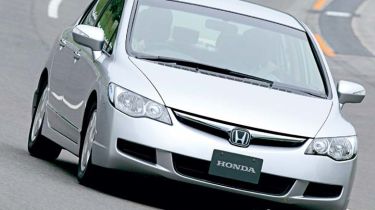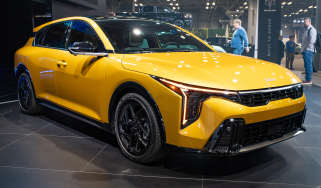Honda Civic
At last! Honda's charge for honours in the family car market has begun. The new Civic hits the road this week, spearheaded by an innovative hybrid - and Auto Express was first behind the wheel.
Hybrid engine technology may once have been dismissed as a futuristic fad promoted by manufacturers hungry for a slice of motor show publicity, but the new Civic proves that it's here to stay. The Honda offers more efficiency, a decent amount of power and, crucially, great value for money. The hi-tech pairing of petrol engines and electric motors goes from strength to strength.
At last! Honda's charge for honours in the family car market has begun. The new Civic hits the road this week, spearheaded by an innovative hybrid - and Auto Express was first behind the wheel.
The petrol-electric saloon is set to debut at the Frankfurt Motor Show, and is being described as the most advanced machine of its type. Aimed squarely at the Toyota Prius, and expected to cost £16,000, the Civic IMA (it stands for Integrated Motor Assist) joins the hatch in UK showrooms in January.
First impressions are mixed. This is actually the eighth edition of Honda's small family car, and the first to be so dependent on design. But the styling of the new four-door is a world away from that of the stunning hatchback, which the manufacturer revealed for the first time at last March's Geneva Motor Show as a bright orange concept car.
While we won't get a chance to drive the hatch until later in the autumn, the firm has tried hard with the saloon. The headlights offer an angular shape, and the grille incorporates a thick chrome centre that bosses say is modelled on the shape of a Japanese Samurai sword.
The sleek profile is enhanced by a generous glass area, a rakish windscreen - which lies at an incredibly shallow angle - and a gently arcing roof. As the car measures 70mm longer, 55mm wider and has a wheelbase 80mm longer than its predecessor, passengers can expect more leg and elbow space. But headroom is a little tighter.
Up front, there's a new cockpit layout, while the seats offer good support. A large dashboard surface area makes front seat occupants feel slightly claustrophobic, and from the driving position it takes a while to work out where the corners of the car are. Otherwise, the interior is well laid out, with a digital speedo and clear switchgear. It's certainly functional, and very practical, too.
As you would expect with a Honda, the Civic's crowning achievement is its engine. The 1.3 i-VTEC is mated to an electric motor and a CVT transmission.
The petrol powerplant also has a new three-stage variable cylinder management (VCM) system, which can shut down fuel supply to selected pistons at cruising speeds. However, floor the throttle and the hybrid accelerates much faster than the outgoing model.
The fact the electric motor is directly attached to the crankshaft means throttle response is swift. The IMA's improved torque also enhances the performance, with the car taking only 11.3 seconds to reach 60mph from a standstill. But despite the increased straight-line pace, fuel economy remains impressive.
In fact, a new generator recovers 10 per cent more braking energy than the previous model, and consumption is reduced by five per cent. Although the official numbers have yet to be revealed, it's thought the combined figure will be close to 60mpg.
The Civic also handles better than the current model, thanks to the addition of speed-sensitive electric power-steering. The suspension is firmer than at present, too, although Honda has managed to balance superb traction with a comfortable ride.
So there's no doubt about it. In terms of performance, handling, ride and economy, this Civic marks yet another step forward for fuel-saving technology.







